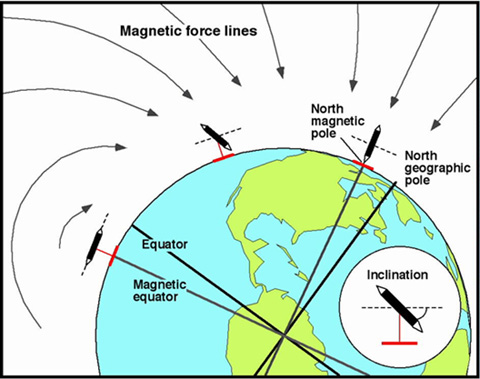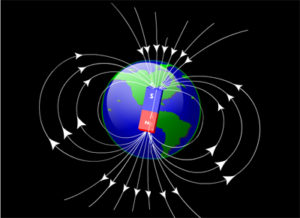For describing the magnetic field of the earth, three magnetic elements are of significant importance. They include the angle of declination, dip, and the horizontal component of the earth’s magnetic field. The magnetic declination is the angle of the horizontal plane, which is between the magnetized compass needle points and the magnetic north. The variation in the angle is dependent on the position of the earth’s surface and changes with time. In the given area, the magnetic declination may be changing slowly over time, possibly only 2-2.5 degrees after the passing of 100 years, and it is dependent on the distance from magnetic poles. For the location which is closer to the poles, the declination can be changed by every 1 degree in three years.

Magnetic Dip
Magnetic dip or inclination is also important as it is the angle that is made by the horizontal magnetic field lines of the earth. There is variation in this angel at various points on earth. The magnetic dip is also known as magnetic inclination, and dip angle. If its value is positive, then it indicates that the earth’s magnetic field is pointing downward, into the earth at the measurement point, and if its value is negative, then it is an indication of pointing of dip angle in an upward direction. A dip circle is a specialized instrument that can be used for the measurement of exact values. This phenomenon is extremely important for aviation purposes.
Horizontal Components of Earth’s magnetic Field
The earth’s magnetic field lines are resembling magnetic field lines of a bar magnet. If the earth is imagined as a bar magnet that is pointing to the north and south pole, then in the various points the shape of lines can be imagined. At the equator, these lines are parallel to the surface of the earth. This is the only horizontal component. There is an angle at the latitudes in between the field lines, to the surface of the earth.

If the field lines can be represented by using the vectors and imaginary arrows can show their direction and size. Imagine if the one-meter arrow is resting at an angle on the floor. Then imagine a shorter vertical arrow, that is sticking up from the same point, on the floor and another shorter horizontal arrow that is on the ground and it’s the tail end is touching the tail end of two others. Now imagines that these arrows have the lengths that can be added together, then the horizontal arrow is the horizontal component of the field of the earth at a point.